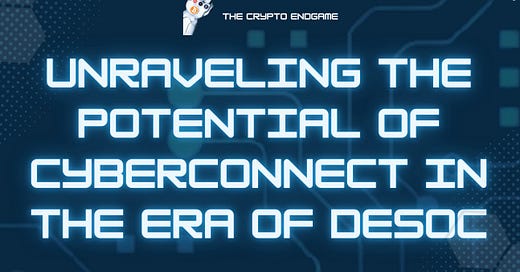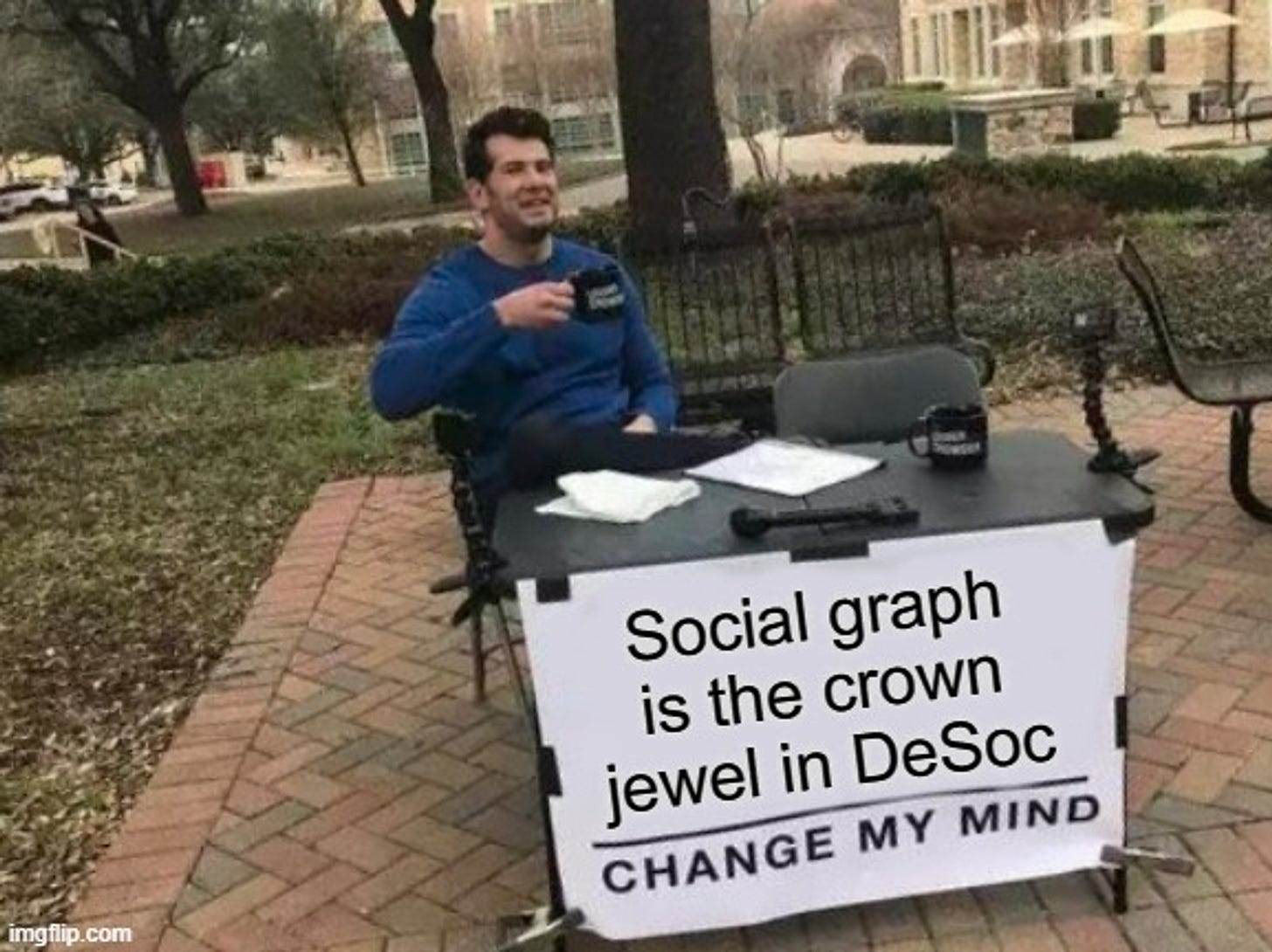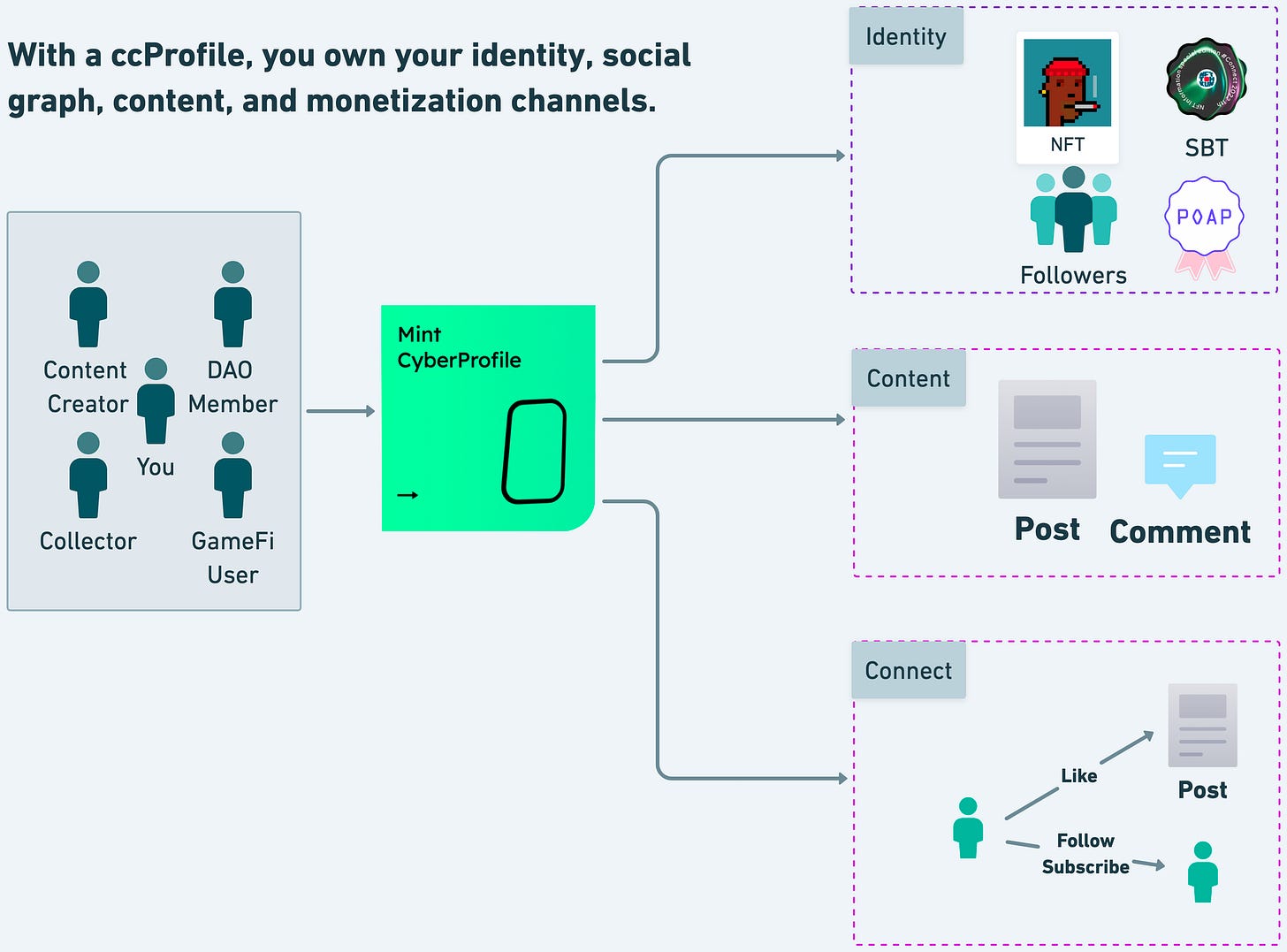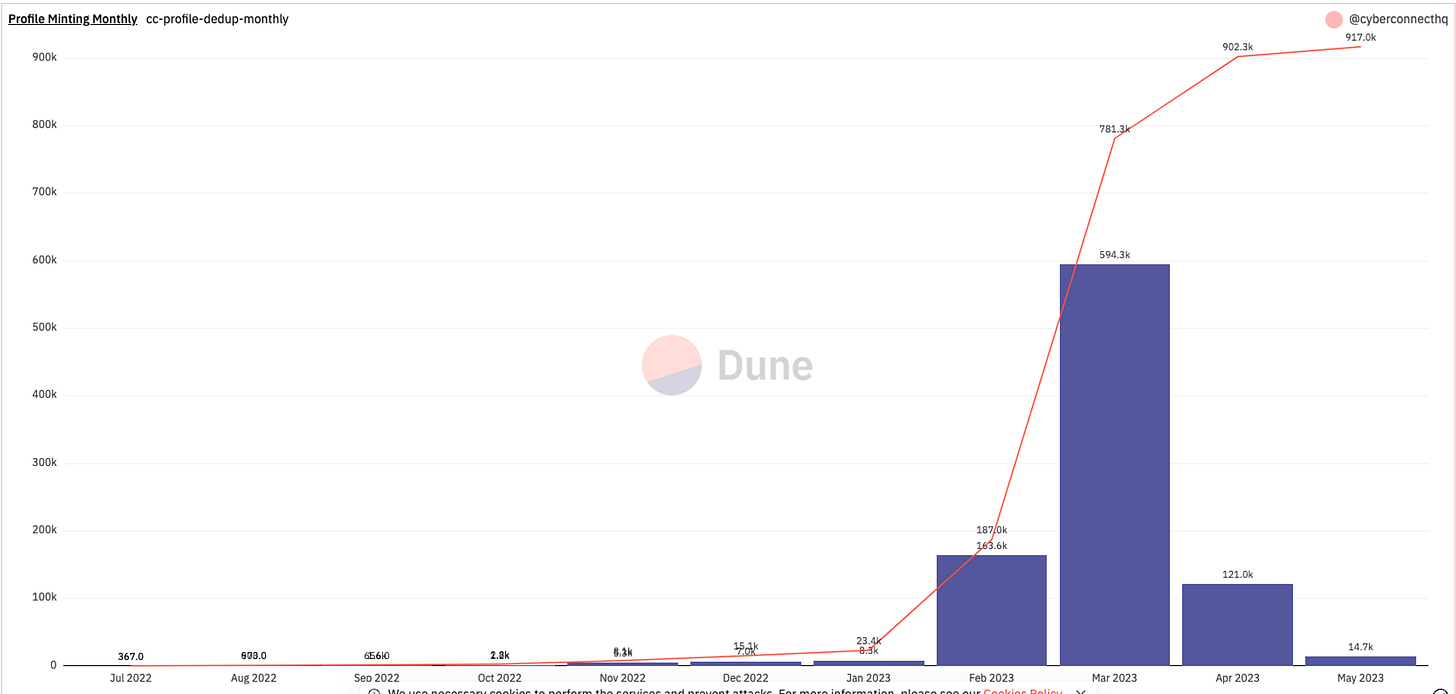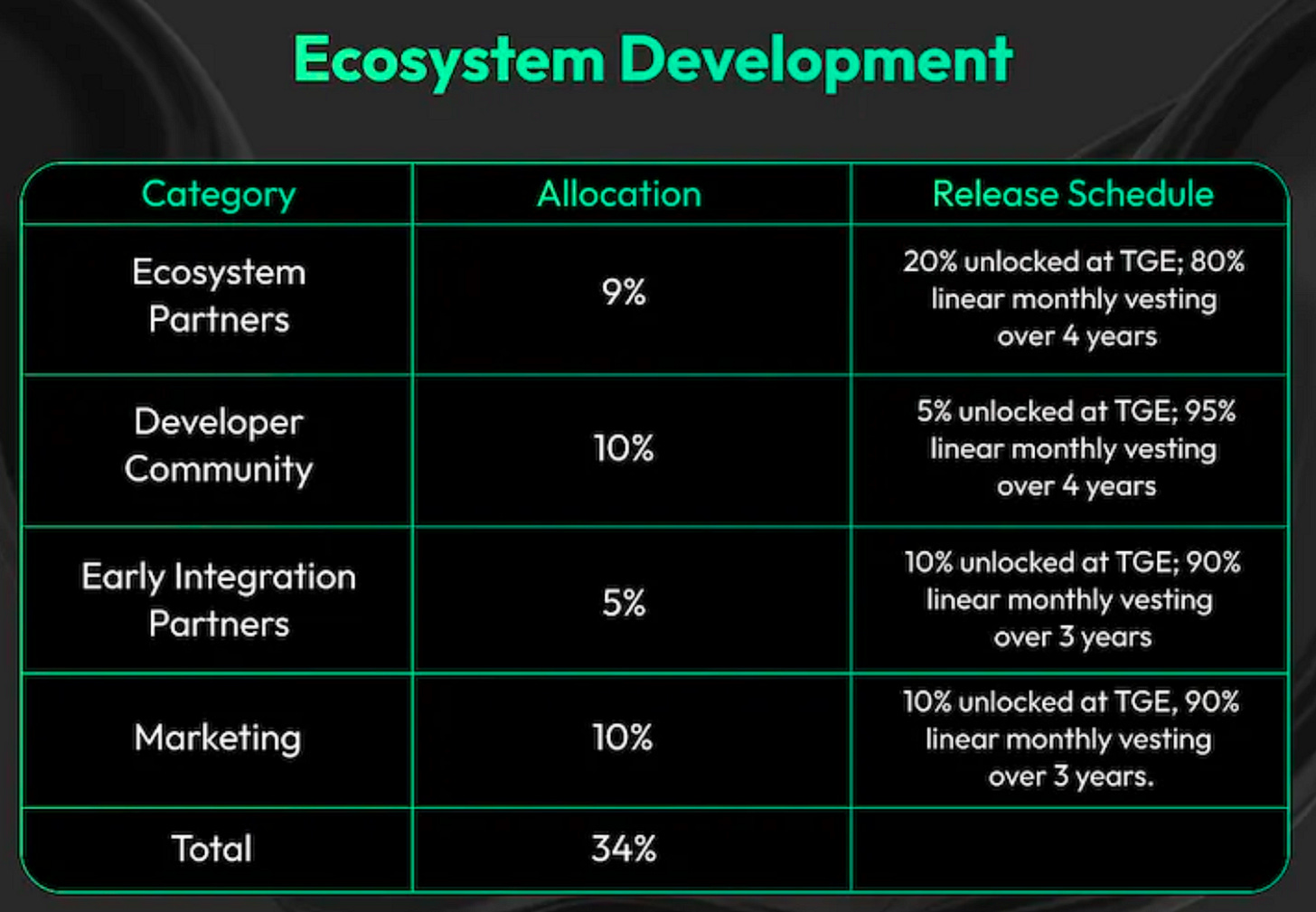Redefining social networks: Unraveling the potential of CyberConnect in the era of DeSoc
DeSoc carries immense potential to transform our social interactions, and CyberConnect is rapidly emerging as one of the frontrunners in this domain.
What is decentralized social and why should I care?
GM anon!
You've likely heard the buzz around decentralized social, or "DeSoc", lately. But what exactly is it?
Let’s jump right in.
The drawbacks of traditional centralized social platform
Consider Twitter as an example. We all enjoy its user-friendly interface, easy interactions, and lightning-fast information sharing. However, everything on Twitter belongs to the platform, not you. Your profile, followers, likes, and retweets – Twitter owns all of it. If you want to move your profile and footprint to another platform? Too bad, you can’t.
Moreover, Twitter's algorithms dictate what you see. It may seem like you're freely exploring the world, but in reality, you're viewing it through a lens provided by Twitter, guiding you to what they want you to see.
They can even ban or delete your account at their discretion. In the worst-case scenario, they could sell your data to a third party or have it leaked to hackers.
As a content creator, you often receive just a small portion of the revenue your content generates, with the platform taking the lion's share.
These concerns apply to all web2 social media platforms. But because they've grown so large and achieved massive network effects, they seem irreplaceable, leaving us with no choice but to keep using them.
However, with the rise of blockchain technology and the expanding web3 community, DeSoc holds the potential to surpass traditional centralized social platforms.
The potentials of DeSoc may drive mass adoption
Censorship Resistance: The cornerstone of DeSoc is open access. No one can change the rules unless the community agrees.
Enhanced User Experience: In DeSoc, experiences can actually be superior. With the ownership of your connections and content, and the evolution of your digital identity into something more holistic, contextual, and verifiable, you enjoy a more seamless and personalized experience that adapts to your contexts. This presents a clear advantage over traditional platforms, adding another layer of appeal to decentralized social platforms.
Decentralized Development: Thanks to the modularity and open-source nature of dApps, each layer of a traditional social platform (e.g., front-end, application infrastructure, social graph, processing, and storage) can be delegated to various developers. This encourages new ideas and features while preventing one platform from monopolizing the entire process.
Interoperability: DeSoc platforms can interact with other decentralized applications and networks, enabling seamless integration of various services and assets. This creates a more connected, efficient, and versatile digital ecosystem.
Community Governance: Decentralized social platforms allow users to have a say in the platform's development, rules, and decision-making. This fosters a sense of ownership and involvement, resulting in a more democratic and user-focused experience.
Token-based Incentives: Through token distribution, content creator, user and platform have closer alignment of interests. This promotes a fairer distribution of revenue and fosters a more supportive ecosystem for all participants.
By addressing the limitations of traditional centralized social platform, DeSoc offers a more equitable, user-centric and community driven alternative, and will become a key attraction for new users to join the web3 world
Social graph is the crown jewel in DeSoc
A social graph represents the connections among users, including friends, followers, content they produce, and interactions on the internet.
Today, we see various types of social media platforms: Facebook focuses on friendships, TikTok on content, messaging apps on communication, LinkedIn on professional networking, and gaming platforms on connecting gamers, among others.
It's common for us to have accounts on multiple platforms, but we can't have a single internet ID that aggregates our entire online presence. This is because closed platforms aim to keep users engaged in their own platform for as long as possible to maximize profits, so they're unwilling to share their collected social graphs.
DeSoc, however, offers a different approach.
Since everything is open-sourced and interconnected, this enables the decoupling of applications from the social graph data layer. This standardizes social graph data accessibility across all applications, promoting unprecedented user experience through interoperability.
Moreover, it introduces an array of new use cases that extend beyond the boundaries of traditional social media platforms. Now, social interaction can occur in any context, much like it does in real life.
This means it's possible to create a unified ID that encompasses not only typical web2 social media information, such as friends, likes, and posts, but also a more comprehensive representation of yourself, including your crypto investments, community participation, and NFT holdings.
From a user's perspective, this makes it a lot easier to find like-minded friends online and creat your own online identity.
From a value perspective, social media relies heavily on marketing and ad revenue. A clearer user profile enables marketers to better identify target audiences, market more efficiently, and generate greater economic value.
However, the value of a social graph layer only increases with its network effect – it becomes more valuable as more people use it. The biggest initial challenge lies in bootstrapping the community for both developers and users.
Ideally, a self-sustaining cycle is created where the social graph layer is interesting enough to attract more developers, who in turn connect their dApps and bring in more users, leading to even more developers and users joining the ecosystem.
What are the options out there?
We're still in the early stages of DeSoc, and the market potential is vast enough to accommodate multiple winners.
Among these players, some of the most talked-about social graphs include Lens, Farcaster, and CyberConnect.
These protocols are all working to build their own social graph layer, but they each take slightly different approaches.
Lens is a smart contract-based social graph, focusing on developer-friendly tools that make it easy to create apps on its infrastructure. It also emphasizes creator economics. However, Lens is only deployed on Polygon, which limits its user base.
Farcaster, on the other hand, is a network-based social graph. It's building its own L2 Farcaster network on Ethereum, creating potential for social MEV.
Lastly, there's CyberConnect, our featured project. It's a multi-chain, smart contract-based social graph with over 1 million total active users.
What is CyberConnect and how does it work?
Launched in 2021, CyberConnect was founded by a team of experienced entrepreneurs, and is now deployed on Ethereum, BNB, and Polygon.
Their mission is clear: Develop a decentralized social network protocol that enables developers to create social applications, connecting users in a fairer, more direct environment.
To realize this mission, the team has a few objectives:
Construct a social graph layer that standardizes social graph data, making DeSoc more streamlined for all users through its NFT profile-focused ecosystem, known as CyberProfile NFT.
Simplify the process for app developers to swiftly create web3 social experiences.
Assist each application in kickstarting their network effect, allowing them to concentrate more on enhancing user experiences.
Foster stronger engagements within creator and organization communities, promote equitable value distribution, and enhance monetization opportunities.
In addition, we observed a few CyberConnect’s unique strategies:
Supplementing specific social use cases. The key to bootstrapping early adopters in a social network is providing specific use cases. Unlike many other players who aim to build a decentralized version of Twitter and Discord (which would be extremely challenging), the CyberConnect team found a market gap and addressed it with its killer app Link3 (more on this later).
Strong integration of applications and social graph. Since a social graph is not an application itself, the key is to onboard users to your social graph without them realizing it. CyberConnect perfectly demonstrates how to address this pain point through the integration of CyberProfile NFT handle and Link3 profile - whenever users wish to create a Link3 profile, they have to mint a CyberProfile NFT with a handle, which will be the name of the NFT and the link to their Link3 profile. In this way, users are unknowingly interacting with the social graph. This seamless onboarding process also applies to all ecosystem projects on CyberConnect network.
Soul-bound CyberProfile. Profiles are meant to be the true identity of yourself and shouldn't be traded, which is why CyberConnect took a soul-bound approach to designing CyberProfile. It's meant to represent who you are.
Chain agnostic. To achieve network effect, a product should be accessible to as many users as possible. That's why CyberConnect is now deployed on multiple chains and looking to further expand its presence to L2s (Arbitrum and Optimism) and other EVM-compatible chains.
But how exactly does the protocol work? Let's dive in.
Smart Contract and Storage Module
To understand CyberConnect's architecture, it's important to recognize that it consists of both on-chain smart contracts and off-chain elements, with good reasons for this design choice.
While smart contracts offer programmability and enable more feature possibilities, they currently face scalability issues and high gas costs due to limitations in layer 1 blockchain infrastructure.
In the long run, accommodating millions of users and billions of social content, and other low value, low scarcity and highly dynamic social engagement data (such as likes and comments) would be impossible if everything were stored on-chain, consuming excessive gas fees.
A more practical design involves keeping less frequent but essential features (such as minting profiles, subscribing, and content ownership) on-chain, while leaving high-frequency actions (like following, liking, posting, and commenting) off-chain and storing them in a decentralized and secure manner.
Now let's explore the smart contract elements - CyberProfile, SubscribeNFT, and EssenceNFT.
CyberProfile
At the core of CyberConnect is the profile NFT called CyberProfile, a soul-bound identity that links both on-chain (wallets, NFTs, etc.) and off-chain (Twitter, Medium, etc.) data.
Minting a CyberProfile is easy on CyberConnect's official website. Just connect your BNB wallet, choose a handle, mint, and you're all set!
You can then view your NFT on OpenSea in the CyberProfile series, featuring the handle you just selected and the system will automatically create a Link3 page with the same handle.
With your CyberProfile, you can display your identity (NFTs, SBTs, etc.), content (posts, comments), and interact with others (like, follow, subscribe).
SubscribeNFT
After a user mints their CyberProfile, they can issue a unique SubscribeNFT, which other users can then collect.
Each SubscribeNFT can be configured with various custom rules, such as:
Pay-to-follow: Requires subscribers to pay a specific amount of tokens to subscribe.
Hold-to-follow: Allows a CyberProfile holder to limit their SubscribeNFT collections to only those who hold a particular EssenceNFT (more on this later), any generic NFT, or even an SBT.
These are just two classic examples. In essence, the SubscribeNFT goes beyond traditional social media interactions like following, liking, and commenting, and opens up endless possibilities for new social connection formats.
EssenceNFT
EssenceNFT is a generic NFT that each CyberProfile holder can issue to represent any piece of content (e.g., posts, videos, publications), or credentials / endorsements.
Each EssenceNFT can be configured with rules like pay-to-mint (crowdfunding), hold-to-mint (community participants), etc. It can also be set up as a tradable NFT or a soul-bound token (SBT) to represent a specific role.
Some use cases include:
Post: Each CyberProfile can create a new piece of content in the form of an EssenceNFT.
Web 3 Status Token (W3ST): CyberConnect-designed SBTs. Common statuses include "community member," "investor," and "event participant."
Storage modules
As mentioned earlier, some of the higher-frequency actions are kept off-chain. CyberConnect provides Scalable Storage Modules (SSM) to store these data in decentralized storage (Arweave), ensuring data sovereignty (can't be forged), integrity (can't be modified without authorization), and availability (can't be censored).
One key concept for storing data in a decentralized storage system is called idempotent proof. For instance, keeping track of every user's following list can be complicated since users constantly add and remove followers. Requiring proof for each action would be costly in a decentralized setting.
With idempotent proof, only the final state of the system at a certain time is recorded, and this state is updated periodically.
SSM supports four different actions: Follow, Like, Post, and Comment. These actions don't require on-chain transactions and aren't represented by NFTs. Instead, they're implemented through off-chain proofs that are synced to Arweave.
The CyberEcosystem
Despite being a relatively young project, CyberConnect has already built a robust and active ecosystem:
Currently, 917K CyberProfiles have been minted, owned by 893K unique owners. Minting reached an all-time high in March 2023, mainly due to the hackathon hosted by CyberConnect and BNB Chain.
CyberConnect’s DAU reached 28K, and MAU reached 183K. According to DappRadar, it is now the #20 web3 protocol by number of unique active wallet in the last 30 days.
1M content created by >110K creators, and >7.5M content collected.
Connected and trusted by over 1,500 ecosystem partners.
50+ projects utilizing CyberConnect’s infrastructure, notable ones include Link3, Phaver, ReadON, Dopamine, Oasis, Mocaverse, and more.
CyberConnect’s flagship social platform, Link3, has 940K MAU.
2,000 verified organizations on Link3, and hosted ~7,500 events.
Backed by reputable investors, including Binance Labs, Multicoin, Animoca Brands, Delphi Digital, IOSG Ventures, Spartan, Hashed, Sky9 Capital, Tribe Capital, Folius Ventures, GGV Capital, SevenX, and many others.
The killer app - Link3
One crucial factor for growing a social graph is having specific social use cases, and Link3 is a powerful product that addresses specific pain points in current web3 social interactions, generating strong demand.
Link3 profile
Link3's key feature is a profile page, similar to Linktree, but it combines web2 info with verifiable web3 info - all in one place. This profile is created automatically when users mint their CyberProfile. On the profile page, users can add links, content, professional experience, NFTs, and credentials that showcase their online identity.
Take Wilson, Co-founder of CyberConnect, as an example. In his profile page, one can see his professional experience (co-founding CyberConnect and DLive), his Twitter link and featured tweet, NFT gallery, interested projects, credentials, and education.
The profile page design is clean and easy to navigate, helping readers understand the person's experiences and interests.
Sharing your Link3 profile is simple—just share the Link3 URL (link3.to/[your handle]) with anyone. For instance, we created our own page while writing this report!
Projects can also create their organization profile. For example, CyberConnect's profile page includes useful links, posts, events, and more.
Event organizing
Another impressive feature of Link3 is event organizing, which addresses the industry's pain points. Projects typically host regular community update calls or AMAs through Discord or Twitter Spaces, and Link3 streamlines the entire process.
With Link3's event function, projects can easily create an event in seconds, including the title, venue (Discord or Twitter), time, speakers, and discoverability (public or only available to certain users).
Next, all this information will be organized into an eye-catching poster that can be shared with the community. It's as simple as that!
Link3 also offers an additional feature which is issuing W3ST (a soul-bound token) to event participants as proof of participation. Identifying truly active, long-term supporters can be a challenge for projects, but with W3ST's soul-bound nature, it becomes simpler to recognize these supporters following their involvement in community activities. From a user's perspective, these tokens help them build their identity, displaying their interests and active participation.
Here’s the best part, after the events, a visualized analytics report is generated, showing audience profiles and details such as the number of participants, when they joined, and how long they stayed. This makes it easy for projects to track the quality of their community interactions.
From a user's perspective, it's incredibly convenient to visit a project's Link3 profile to see all upcoming events, whether hosted on Twitter or Discord. Just click "add to calendar," and an invite will be sent directly to your Gmail account.
Users can also explore upcoming events hosted by the projects they follow, making it easy to stay engaged and informed.
Other features
Link3 also launched its own Post function, comparable to Mirror. This feature allows organizations to directly post content on their pages, supplemented with social and management tools that foster improved community engagement.
Fanclub visualizes your engagement with the CyberConnect universe. The more you interact with the protocol, the higher points you gain and higher level you elevate, which should unlock further community rewards in the future 👀
Product roadmap
The team has outlined clear and specific deliverables to further expand their products and ecosystem. The most crucial ones include upgrading the protocol to v3 and launching their own ERC-4337 compatible CyberWallet.
As we mentioned in our previous research report, smart contract wallets are essential for unlocking mass adoption. This is why the CyberConnect team also recognizes the need to launch its wallet in order to provide the smoothest user onboarding experience.
2023 Q3
Launch CyberConnect v3 and expand to other EVM-compatible chains
Launch a beta version of CyberWallet that is ERC-4337 compatible and integrates with the CyberConnect social graph module, making onboarding even more user-friendly
Upgrade .cyber to an omni-chain name
2023 Q4
Enable web2 social login, social recovery, and developer SDKs for CyberWallet
Launch grant program for developer onboarding and ecosystem development
$CYBER tokenomics
CyberConnect announced its public token sale $CYBER on Coinlist. $CYBER will have a total supply of 100M tokens.
Distribution & vesting
40.12% to insiders (team & advisors + private sale) is fair, and its vesting schedule of c. 4 years is also fair.
The remaining are split among different uses for the rewarding to community and growth of ecosystem, at reasonable terms. See specific breakdown below:
Supply and inflation
Total supply of $CYBER is capped at 100M, with a reasonable circulation.
Demand and utilities
The team has already implemented several utilities for the $CYBER token:
Payment for CyberProfile: The token can be used to pay for a CyberProfile with a premium username.
Payment for gas in CyberWallet: The token serves as a price meter and can be used to pay for gas fees for transactions within the CyberWallet.
Governance
While the current utilities may not appear extensive, we believe the team is dedicated to adding more features to the token as they continue to launch new products and update the protocol.
Team
The project was founded by serial entrepreneurs who have been working together for quite a while.
Their previous project, DLive, was a decentralized live streaming platform with ~1M DAU and had the #1 Youtube Pewdiepie streaming exclusively, and was successfully acquired by BitTorrent.
Ryan: Co-founder & CTO at DLive, software engineer at Instagram and Google
Wilson: Chairman at DLive
Shiyu: Co-founder at DLive
Zhimao: Head of engineering at DLive, software engineer at Google and Facebook
Conclusion
We're optimistic about DeSoc's potential in contrast to traditional centralized platforms, and we believe it will become a superior option as the technology and community evolve.
Within DeSoc, we see the separation of social graph data from applications as critical, unlocking endless possibilities for interoperability.
Though this field is still at its very early stage, CyberConnect stands out as a rapidly growing leader that is worth keeping an eye on.
The team has a clear vision of building a decentralized platform and simplifying DeSoc for the web3 community, adopting several unique strategies that favorably position the project.
Its killer app, Link3, offers exceptional features and showcases impressive growth. The upcoming $CYBER token launch is expected to further unify and invigorate the community.
We will keep an eye on industry trends and CyberConnect's progress, and will provide updates in the future.

